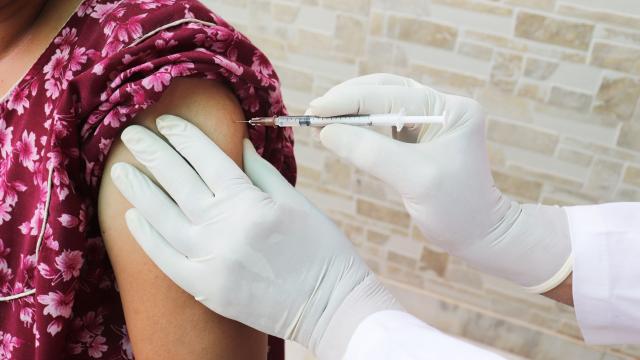Australia’s Therapeutic Goods Administration (TGA) is set to approve a third COVID-19 vaccine — Moderna — within the next fortnight in what can only be described as a win for our vaccine rollout.
Yes, the vaccine that was partly funded by country music icon Dolly Parton should be on our shores and in our arms before the end of the year. Yeehaw!
So what do we know about the Moderna vaccine and how will the rollout work in Australia?
What Is The Moderna Vaccine?
Moderna is a COVID-19 vaccine that is pretty similar to the Pfizer shot we’ve had in Australia for months now.
Like Pfizer, Moderna uses the mRNA technology — which had previously been tested in human trials, but wasn’t approved for widespread use prior to the COVID-19 pandemic.
But while it’s similar to Pfizer, it is not the same, with Moderna containing 100 micrograms of the vaccine, while Pfizer only contains 30 micrograms.
How Many Doses Do We Have?
Back in May, Federal Health Minister Greg Hunt confirmed that Australia has struck a deal to secure 25 million doses of Moderna, pending its TGA approval.
The first 10 million doses are set to arrive before the end of the year, with an additional 15 million scheduled to be delivered in 2022.
However, it’s also worth noting that Moderna is in talks with the Australian government about producing the vaccine locally, which could see our supply increase.
“We appreciate the partnership and support from the government of Australia with this first supply agreement for doses of the Moderna COVID-19 vaccine and our variant booster candidates,” Stephane Bancel, Chief Executive Officer of Moderna, said in a statement at the time.
“As we seek to protect people around the world with our COVID-19 vaccine and potentially our variant booster candidates, we look forward to continuing discussions with Australia about establishing potential local manufacturing opportunities.”
When Will It Be Rolled Out?
If approved by the TGA, we could see Moderna rolled out as early as next month.
“Best advice is that we’re likely to receive approval from the TGA — but it is in their hands — within the next two weeks,” Hunt said in a statement.
“And that we would receive a million doses during the course of September, and then three million in each of October, November and December.”
Who Will Get The Jab?
Ten million of Australia’s Moderna doses will go to unvaccinated people, while the additional 15 million will be used as booster shots to help target new variants in people who have already received Pfizer or Astra Zeneca.
This means that even if you’ve had AZ, you could still end up getting Moderna as a booster down the track.
Similarly to the Pfizer vaccine, Moderna is expected to be given to children as young as 12. However, this will require separate TGA approval to the adult approval that is currently pending.
In the US, Moderna is approved for people over the age of 18. However, Australia is yet to determine guidelines for who will be eligible and recommended for the Moderna jab.
How Effective Is Moderna?
In the original clinical trial, Moderna reported a 94 per cent efficacy. More recently, Moderna has asserted that the vaccine is approximately 93 per cent effective six months after the second dose has been administered, which is virtually on par with the initial trial.
According to Yale Medicine, Moderna has more than 95 per cent efficacy against severe cases of COVID-19, which is the main concern with the virus. Comparatively, Pfizer has a 96 per cent effectiveness against hospitalisation for the Delta variant, while AstraZeneca has a 92 per cent effectiveness.
Realistically speaking, all three vaccines do a really great job at keeping you protected from COVID-19 and minimising your risk of ending up in ICU. All three vaccines are safe and effective, and if you can get a vaccine, you should.
What Are The Side Effects?
According to the US Centers for Disease Control and Prevention (CDC), the Moderna side effects are relatively minor. Symptoms include:
- Pain, swelling or redness in the arm you received the shot
- Tiredness
- Headache
- Muscle pain
- Chills
- Fever
- Nausea
According to research from Oxford University, the blood clot risk from Moderna (or Pfizer) is four per million doses. This is lower than the risk in AstraZeneca, which ranges from 1.4-3.1 per 100,000 doses, depending on your age.
How Many Shots Do I Need?
Like the other two vaccines in Australia, Moderna requires two doses for maximum protection.
Booster shots are currently being tested and should be approved for use in the US next month. There’s no word yet on when Australia could start rolling out booster shots.
Is It Easier To Store?
A major issue with vaccines so far has been storage, with COVID-19 jabs requiring super cold storage prior to being injected. Thankfully, Moderna is much easier to store.
The Pfizer vaccine needs to be stored at a freezing -75 degrees Celcius, while Moderna can safely be stored at -20 degrees, which is roughly the same temperature as the ice cream in your freezer.
Should I Wait For Moderna?
As experts have repeatedly stressed: the best vaccine is the one that’s available to you right now.
Moderna is another option on the table, but it doesn’t mean you should wait for it to be available before getting the jab.
Obviously, AstraZeneca isn’t recommended to everyone, so it’s handy to know that there will be another alternative. But as the highly contagious and deadly Delta variant continues to spread across the country at a rapid pace, the official ATAGI advice remains as follows:
“ATAGI also recommends adults under the age of 60 who do not have immediate access to the Pfizer vaccine should consider the benefits and risks of earlier protection through the AstraZeneca vaccine.”

Comments